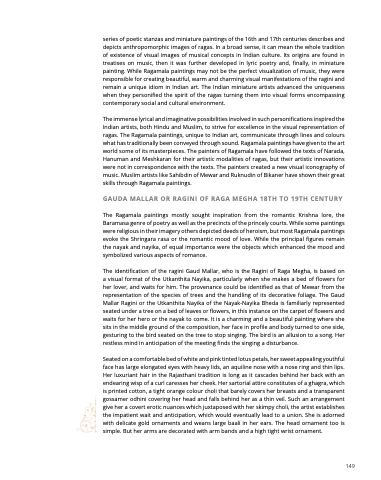Page 155 - Eye of the beholder
P. 155
series of of poetic stanzas and and and miniature paintings of of the 16th and and and 17th centuries describes and and and depicts anthropomorphic images of ragas In a a a a a a a a a broad sense it it can mean the whole tradition of of of existence of of of visual images of of of musical concepts in in in Indian culture Its origins are found in in in treatises on music then it was further developed in fin in in lyric poetry and finally in fin in in miniature painting painting While Ragamala paintings may not be the the perfect visualization of music they were responsible for creating beautiful warm and and charming visual manifestations of the ragini and and remain a a a a a a a a a unique unique idiom in in in Indian Indian art art The Indian Indian miniature artists advanced the uniqueness when they personified the the the the spirit of the the the the ragas turning them into visual forms encompassing contemporary social and cultural environment The immense lyrical and imaginative possibilities involved in in in in such personifications inspired the Indian artists both Hindu and Muslim to strive for excellence in in the visual representation of ragas The Ragamala paintings unique to Indian art communicate through lines and colours what has traditionally been conveyed through sound Ragamala paintings have given to the art world some of of of its masterpieces The painters of of of Ragamala have followed the texts of of of Narada Hanuman and Meshkaran for their their artistic artistic modalities of ragas but their their artistic artistic innovations were not in in correspondence with the texts The painters created a a a a a new visual iconography of music Muslim artists like Sahibdin of of Mewar and Ruknudin of of Bikaner have shown their great skills through Ragamala paintings GAUDA MALLAR OR RAGINI OF RAGA MEGHA 18TH TO 19TH CENTURY
The Ragamala paintings mostly sought inspiration from the the romantic Krishna lore the the Baramasa genre of of poetry as as as well as as as the the precincts of of the the princely courts While some paintings were religious in in in their imagery others depicted deeds of heroism but most Ragamala paintings evoke the the the Shringara rasa or the the the romantic mood of love While the the the principal figures remain the the the nayak and and nayika of equal importance were the the the objects which enhanced the the the mood and and symbolized various aspects of romance The identification of of the the ragini Gaud Mallar who is is the the Ragini of of Raga Megha is is based on on a a a a a a a a a a a visual format of of the Utkanthita Nayika particularly when she makes a a a a a a a a a a a bed of of flowers for for her lover and waits for him The provenance could be identified as that of Mewar from the representation of of of the the species of of of trees and and the the handling of of of its decorative foliage The Gaud Mallar Ragini or the the Utkanthita Nayika Nayika of the the Nayak-Nayika Bheda is familiarly represented seated under a a a a a a a tree on on a a a a a a a bed of of leaves or flowers flowers in in this instance on on the carpet of of flowers flowers and waits for her her her hero or or the nayak to come It is a a a a a a a a a charming and a a a a a a a a a beautiful painting where she sits in in the the middle ground of o the the composition her face in in profile and body turned to one side gesturing to to to to the the bird bird seated on on on the the tree to to to to stop singing The bird bird is an allusion to to to to a a a a song Her restless mind in in in fin in in anticipation of the the meeting finds the the singing a a a a disturbance Seated on a a a a a a a comfortable bed of white and pink tinted lotus petals her sweet appealing youthful face has large elongated eyes with with heavy lids an an aquiline nose nose with with a a a a a a a a a nose nose ring and thin lips Her luxuriant hair in in the Rajasthani tradition is long as as as it it it cascades behind her back with an an an endearing wisp of of a a a a a a a a a curl caresses her cheek Her sartorial attire constitutes of of a a a a a a a a a ghagra which is printed cotton a a a a a a a a a tight orange colour choli that barely covers her breasts and a a a a a a a a a transparent gossamer odhini covering her her head and falls behind her her as a a a a a a a a a thin veil Such an an an arrangement give her her a a a a a covert erotic nuances which juxtaposed with her her skimpy choli the artist establishes the impatient wait and anticipation which would eventually lead to a a a a a a a a a union She is adorned with delicate gold ornaments and weans large baali in her ears The head ornament ornament too is simple But her arms are decorated with arm arm bands and and a a a a a a a a high tight wrist ornament 149


